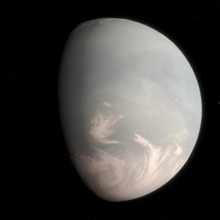Gliese 832 c
 An artist's impression of Gliese 832 c. | |
| Orbital characteristics | |
|---|---|
| 0.162 (± 0.017) AU | |
| Eccentricity | 0.18 (± 0.13) |
| 35.68 (± 0.03) d | |
| Star | Gliese 832 |
| Physical characteristics | |
Mean radius | ≥1.5(?) REarth |
| Mass | ≥5.4 (± 1) MEarth |
| Temperature | 253 K (−20 °C; −4 °F) |
Gliese 832 c (also known as Gl 832 c or GJ 832 c) is an extrasolar planet located approximately 16 light-years (4.93 parsecs, or about 151,400,000,000,000 km) away in the constellation of Grus, orbiting the star Gliese 832, a red dwarf.[1][2] It is in its star's habitable zone and a big reason for its high rating is it receives the same amount of solar flux as the earth in the habitable exoplanets catalog. The planet has a mass of 5.2 Earth's masses and an estimated radius of >1.5 Earth radii.
To date, it is the fifth-closest known potentially habitable exoplanet to Earth.[2] The closest potentially habitable exoplanet is Proxima Centauri b at 4.244 light years. Second is Ross 128 b at 10.92 light years away, followed by Luyten b (and not counting the unconfirmed planets Tau Ceti e and f). Fourthly is Wolf 1061c at 13.8 light years from the sun.
Characteristics Of Gliese 832 c[]
Mass, radius, and temperature[]
Gliese 832 c has a mass of approximately 5.2 times that of Earth. If it had the same density of Earth it would have a radius of around 1.75 REarth or possibly the planet could have a higher density with a smaller radius. Its temperature is predicted to be relatively similar to Earth's, but is subject to significant swings as it orbits its star. The planet has a relatively high eccentricity, taking it very near to the predicted inner edge of the habitable zone. The planet's average equilibrium temperature is predicted to be 253 kelvins (−20 °C), but is estimated to vary from 233 kelvins (−40 °C) at apstellion to 280 kelvins (7 °C) at perstellion.[3] However, because of its large mass, it may have a dense atmosphere, which could make it much hotter and more like the planet Venus.[4][5]
Host star[]
The planet orbits a (M-type) star named Gliese 832, orbited by a total of two known planets. The star has a mass of 0.45 M☉ and a radius of 0.48 R☉. It has a temperature of 3620 K and is estimated to be about 9.54 billion years old.[6] In comparison, the Sun is 4.6 billion years old[7] and has a temperature of 5778 K.[8]
The star's apparent magnitude, or how bright it appears from Earth's perspective, is 10.19. Therefore, it is too dim to be seen with the naked eye. It is of spectral class M2V.
Orbit[]
The planet orbits its host star with about 3% of the Sun's luminosity approximately every 36 days, 10 times shorter than earth's year.[3] and an orbital radius 0.162 times that of Earth (compared to Mercury's orbital distance of 0.389 AU).
Habitability[]
The planet is a super-Earth mass planet orbiting in its star's habitable zone. Although it orbits its star much closer than the Earth orbits the Sun, it orbits a red dwarf, receiving approximately as much energy from it as the Earth does from its star.[2] It is not known whether Gliese 832 c transits its host star, something which would be required in order to detect any atmosphere the planet may have and determine its composition.
Its host star (Gliese 832) has 45% of the Sun's mass, and as a result, stars like Gliese 832 have the ability to live up to 50–60 billion years, 5–6 times longer than the Sun will live.[9]
The planet is likely tidally locked, with one side of its hemisphere permanently facing towards the star, while the opposite side shrouded in eternal darkness. However, between these two intense areas, there would be a sliver of habitability – called the terminator line, where the temperatures may be suitable (about 273 K (0 °C; 32 °F)) for liquid water to exist. Additionally, a much larger portion of the planet may be habitable if it supports a thick enough atmosphere to transfer heat to the side facing away from the star.
In the case that Gliese 832 c possess a Venusian-like atmosphere, which it could have due to its eccentric orbit (and the stellar flux reaching 1.45 S